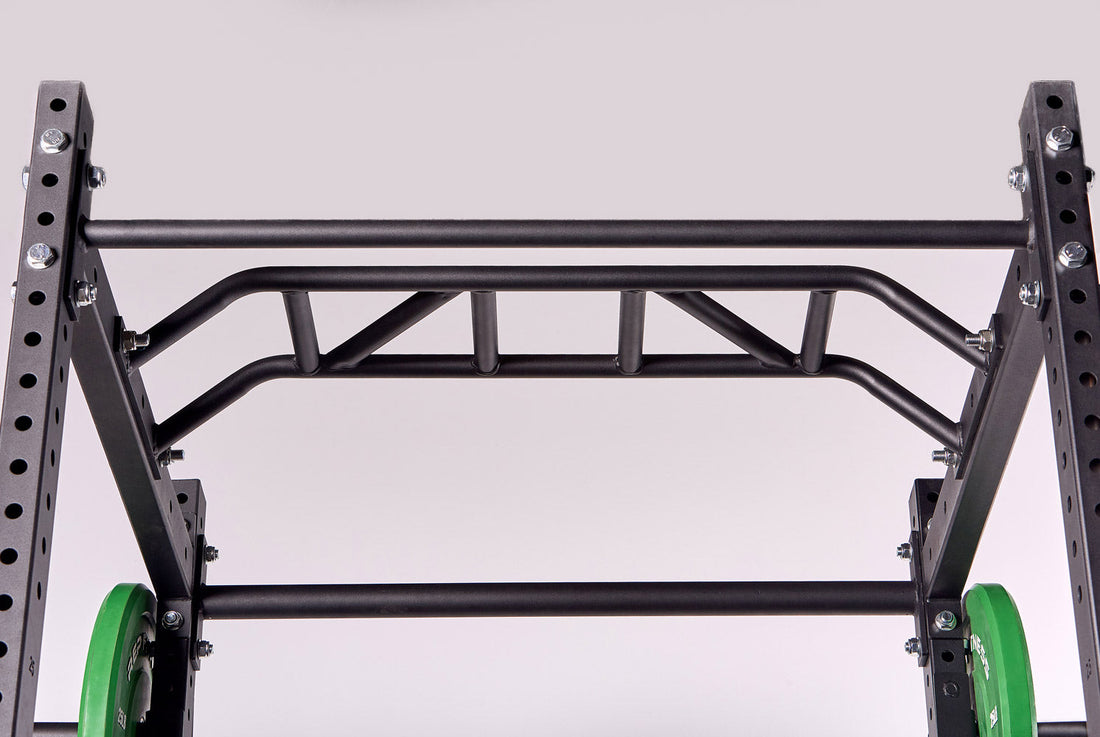
Changing your hand position on the pull-up bar can alter the muscles you target.
Here's a quick look at 11 different hand positions for pull-ups and the muscle groups each one emphasizes. A Multi-Grip Pull-Up Bar with all the different bar angles adds a ton of versatility. Here's a look at all the different kinds of pull-up bars.
Whether you're aiming to diversify your workout or address specific muscle imbalances, understanding these variations can help you make the most out of your pull-up sessions.
1. Standard Pull-Up (Overhand Grip)

Hand Position: Hands shoulder-width apart, palms facing away from you.
Targeted Muscles:
- Primary: Latissimus dorsi (lats)
- Secondary: Biceps brachii, brachialis, brachioradialis, trapezius, rhomboids, infraspinatus, teres major, and posterior deltoids
The standard pull-up is the classic version most people are familiar with. By using an overhand grip, you primarily engage the lats, which are the broad muscles on the sides of your back. This grip also recruits your biceps and other supporting muscles, making it a comprehensive upper-body workout.
2. Chin-Up (Underhand Grip)

Hand Position: Hands shoulder-width apart, palms facing towards you.
Targeted Muscles:
- Primary: Biceps brachii
- Secondary: Latissimus dorsi, brachialis, brachioradialis, trapezius, rhomboids, pectoralis major, and infraspinatus
Chin-ups switch the emphasis from the lats to the biceps due to the underhand grip. This variation is excellent for those looking to build arm strength and size. Despite the increased bicep involvement, your lats still get a good workout, making chin-ups a valuable addition to your routine.
3. Wide-Grip Pull-Up

Hand Position: Hands wider than shoulder-width, palms facing away from you.
Targeted Muscles:
- Primary: Latissimus dorsi
- Secondary: Teres major, infraspinatus, trapezius, rhomboids, posterior deltoids, and biceps brachii
By widening your grip, you place more focus on your lats, making this variation one of the most challenging and effective for back development. The wider grip reduces bicep involvement, forcing your back muscles to work harder.
4. Close-Grip Pull-Up

Hand Position: Hands closer than shoulder-width, palms facing away from you.
Targeted Muscles:
- Primary: Latissimus dorsi, lower trapezius
- Secondary: Biceps brachii, brachialis, brachioradialis, rhomboids, and infraspinatus
Close-grip pull-ups emphasize the lower part of the lats and the center of your back. This variation also increases the range of motion, which can help improve overall strength and muscle engagement.
5. Neutral-Grip Pull-Up

Hand Position: Palms facing each other, using parallel bars on a Multi-Grip Pull-Up Bar.
Targeted Muscles:
- Primary: Latissimus dorsi, biceps brachii, brachialis, brachioradialis
- Secondary: Trapezius, rhomboids, posterior deltoids, and infraspinatus
Neutral-grip pull-ups are kinder to your shoulders and elbows due to the natural hand position. This variation offers a balanced workout, engaging both your lats and biceps equally, and is ideal for those who experience discomfort with overhand or underhand grips.
6. Commando Pull-Up
Hand Position: Hands positioned on either side of the same bar, palms facing each other. Picture grabbing the bar with one hand just in front of the other, facing the side of the rack. See an example of a commando pull-up here.
Targeted Muscles:
- Primary: Biceps brachii, brachialis, brachioradialis
- Secondary: Latissimus dorsi, trapezius, rhomboids, posterior deltoids, and infraspinatus
Commando pull-ups are a unique variation that combines elements of both the neutral and overhand grips. This position requires significant core stability and engages your biceps intensely due to the alternating side-to-side motion.
7. Archer Pull-Up

Hand Position: One hand in a standard pull-up position and the other extended out to the side.
Targeted Muscles:
- Primary: Latissimus dorsi, biceps brachii, brachialis, brachioradialis
- Secondary: Trapezius, rhomboids, posterior deltoids, and infraspinatus
Archer pull-ups are an advanced variation that targets one side of your body more intensely. This move requires considerable strength and coordination, making it an excellent progression towards mastering one-arm pull-ups.
8. Angled-Grip Pull-Up
Hand Position: Hands placed on angled bars of a Multi-Grip Pull-Up bar, allowing for a natural wrist position.
Targeted Muscles:
- Primary: Latissimus dorsi, biceps brachii, brachialis
- Secondary: Trapezius, rhomboids, posterior deltoids, and infraspinatus
Angled grips provide a more ergonomic position for the wrists, reducing strain and allowing for a comfortable yet effective workout targeting the lats and biceps.
9. Mixed-Grip Pull-Up

Hand Position: One hand in an overhand grip, the other in an underhand grip.
Targeted Muscles:
- Primary: Latissimus dorsi, biceps brachii, brachialis, brachioradialis
- Secondary: Trapezius, rhomboids, posterior deltoids, and infraspinatus
The mixed grip provides a unique challenge, engaging both the lats and biceps in different ways. This variation also helps in building grip strength and coordination.
10. Towel Pull-Up

Hand Position: Holding onto towels draped over the pull-up bar.
Targeted Muscles:
- Primary: Latissimus dorsi, biceps brachii, brachialis, brachioradialis
- Secondary: Trapezius, rhomboids, posterior deltoids, and infraspinatus
- Additional: Forearms, grip strength
Using towels adds an extra challenge by significantly increasing the demand on your grip strength and forearms, while still targeting the lats and biceps.
11. Eccentric (Negative) Pull-Up

Hand Position: Any grip, focusing on the lowering phase.
Targeted Muscles:
- Primary: Latissimus dorsi, biceps brachii, brachialis, brachioradialis
- Secondary: Trapezius, rhomboids, posterior deltoids, and infraspinatus
Eccentric pull-ups focus on the lowering phase of the movement, which helps build strength and muscle control. This variation is excellent for those working towards their first full pull-up or looking to break through plateaus.
Bottom Line
Incorporating different hand positions into your pull-up routine can help you target various muscle groups more effectively and prevent workout monotony. By understanding the specific muscles each variation emphasizes, you can tailor your training to meet your fitness goals.
Whether you're aiming to build bigger biceps, broaden your back, or achieve a well-rounded upper body, there's a pull-up variation that can help you get there. So, mix it up, challenge yourself, and unlock your full potential on the pull-up bar!

NEWSLETTER SIGNUP
Product launch information, promotions, blogs, and REP news.







